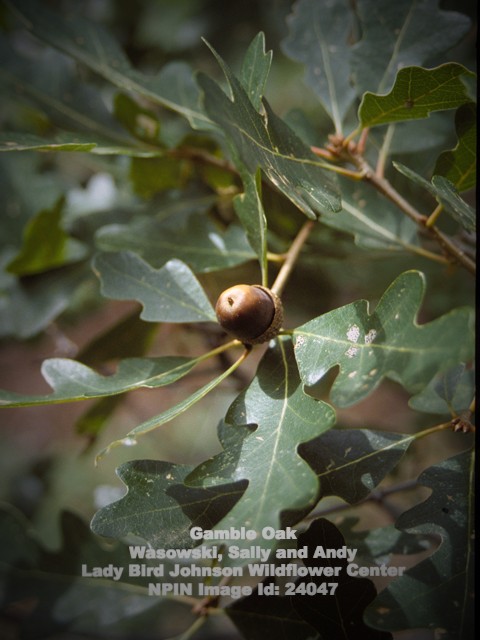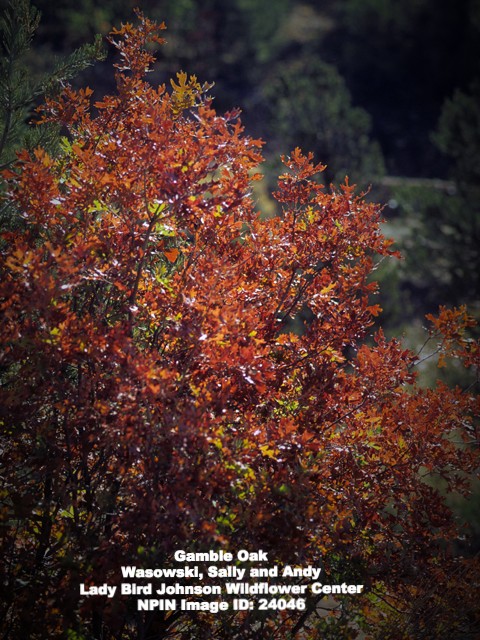By: Deborah Lebow Aal
Why Oaks? I mentioned in my article, Native Trees for Colorado’s Front Range, that tree experts on Colorado’s Front Range feel that Oak trees should fill that gap between true natives and non-natives. They do really well here on the Front Range, provide ample opportunity for hosting many insects, and, contrary to popular belief, are not slow growers. Doug Tallamy* uses an Eastern Oak as his example of the difference between native trees and exotics in terms of being host plants in your landscapes. Tallamy says a native oak tree can support the caterpillars of over 500 species of butterflies and moths. These caterpillars are a critical food source for over 96 percent of songbirds. He goes on to say a pair of Carolina chickadees require between 6,000 to 9,000 caterpillars to successfully raise just one brood of young birds. In contrast, an exotic, i.e., non-native tree like a ginko, supports the caterpillars of about 4 species of butterflies and moths.

I know, that’s an eastern U.S. – centric example. We have two species of oak trees that do quite well on the Front Range, and are considered “almost native.” Before getting into the two, I want to discuss what an oak tree needs, and then, what it “gives.” To grow and be healthy, an oak needs water, air, appropriate soil conditions, sunlight, protection from harmful insects, and pollination assistance. That sounds like a lot – and it’s what most trees require, but it’s not a lot when you consider what an oak tree provides. It provides acorns – food for humans and wildlife; is a host for possibly more caterpillars than any other plant you can plant, which means it is providing incredible support to birds and to the food web in general**; shade; air purification; humidity; temperature modification; leaves for mulch***; spongy high humus soil that holds rainwater; high quality hardwood; twigs and branches; carbon sequestration; and privacy. That’s what I can think of – there are probably additional items an oak tree provides. It’s extremely hard to quantify those benefits, but if you did, they’d add up to an impressive dollar amount.
The importance of trees, not just oaks, in this era of climate change cannot be overstated. First, they are the best plants to support wildlife, as mentioned above. Butterflies and moths rely largely on trees as host plants for their caterpillars, which birds and other animals rely on as a key food source. Shrubs and perennial flowers support just a fraction of the butterflies and moths that trees do. Equally as important, as climate change is making many landscapes hotter and drier, the cooling properties of trees become much more important. If you’re planting a tree for shade and cooling, why not plant one that supports a multitude of species. Here are two oak trees that do well on the Front Range, and in my humble opinion, should be included in everyone’s landscape.

Gambel Oak (Quercus gambelii)
This tree was not in my article on Native Trees for the Front Range. That’s because it’s truly native to parts a little bit south of the Front Range. But, as climate change changes things here, perhaps it’s one we should claim as a native. As mammals are moving north, research on climate change shows that plants are not moving as fast as animals. It may be up to us to help plants move a little faster. This tree is really drought tolerant. It is good in USDA hardiness zones 3-6, and it is good up to an altitude of 9,800 feet.

A gambel oak should actually be part of a ponderosa pine guild. What is a guild, you might ask? A guild is a grouping of plants that benefit each other and should be planted together. Often, they are what’s found growing together in the wild, like the gambel oak and ponderosa pine, but sometimes, it’s us humans providing helper plants. It’s an important concept in permaculture (a subject of another article in the future). These oak trees do well as an understory tree to a ponderosa pine. The reason I didn’t write an article on ponderosa pines instead of oaks, is that they can be such large trees when full grown, that they scare most gardeners away. I do not have a ponderosa pine on my little urban landscape, but I do have a gambel oak (it’s tiny but it’s growing!). So, despite the fact that an oak tree would do well planted with a ponderosa pine, I am recommending other plants that can and should be planted in an oak tree guild, i.e., around the oak tree. They are: native currents, gooseberries, sumac, and elderberry; prickly pear (Opuntia), Bee balm (Monarda fistula), lupine, yarrow (Achillea millefolium), and Allium. Allium are particularly good for fungi that the oak needs, but all of these plants would provide something that the oak tree would benefit from, and support its growth certainly better than what we usually see, which is one tree surrounded by a sea of grass. That’s not how they grow in the wild.
Gambel oaks are known to be a little scruffy looking, but there are two beautiful specimens at the Denver Botanic Gardens that demonstrate that if you prune them correctly, they are a perfectly beautiful landscape tree. They are also salt resistant, which could be important in times of drought.
In terms of how many species of caterpillars our native oaks might support, I could not find any information specifically on gambel oaks, but there is an oak native to the Flagstaff, AZ area, just a bit south of here, Quercus fagales. which 228 species of moths and butterflies use as a host plant, and I am guessing that could be close to the number for the gambel oak.

Chinkapin Oak (Quercus muehlenbergii)
The chinkapin oak is rather similar to the gambel oak. I am not as familiar with it as I do not have one in my landscape, but tree experts have mentioned this oak in many talks I have attended as recommended for home landscapes. Its qualities are similar to the gambel oak, except that it does well only up to an elevation of 6,500 feet. It is truly native to areas just east and south of the Front Range, but as mentioned, with climate change, we might want to nudge it up here. It does not have your typical oak leaf it is a toothed leaf like those of a chestnut tree, but the leaves, in my opinion, are particularly lovely.
If you have pictures of your oak trees that you’d like to share, or other oaks that do well on the Front Range, I would be happy to receive them and share them in the future.
Thanks for reading!
* Douglas W. Tallemy has been mentioned numerous times in Front Range Wild Ones’ articles. He is a professor of entomology at the University of Delaware, and is the author of Bringing Nature Home. He is a big proponent of native plants in home landscapes. http://www.bringingnaturehome.net
** “A single oak tree can support up to a million organisms…” From High-Impact Low-Carbon Gardening, by Alice Bowe.
*** For mulch, I use almost exclusively leaves from my yard and my neighbors, who are more than happy to give me their leaves.
